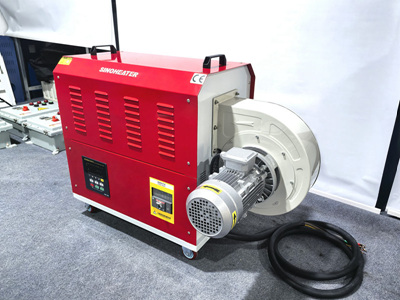Precision Heating Techniques for Baking Mold Disinfection Using Hot Air Blowers
Baking mold disinfection demands precise temperature control and uniform heat distribution to eliminate microbial contaminants without damaging mold surfaces. Hot air blowers, when integrated with advanced thermal management systems, provide an efficient solution for industrial and artisanal bakeries. This guide explores technical parameters, equipment configurations, and quality assurance protocols for achieving hygienic standards in mold processing.
Temperature Management for Microbial Elimination
Effective disinfection requires heating molds to temperatures that disrupt microbial cell structures. The thermal death point for common bakery pathogens—such as Bacillus subtilis and Aspergillus niger—ranges between 80°C and 100°C, depending on exposure duration.
Heating Stages:
- Preheating Phase: Gradually raise mold temperature to 60–70°C over 8–10 minutes to prevent thermal shock.
- Disinfection Phase: Maintain 85–95°C for 15–20 minutes, ensuring all mold surfaces reach the target temperature.
- Cooling Phase: Reduce temperature to 40°C at a rate of 3–5°C per minute to avoid condensation.
Material-Specific Adjustments:
- Silicone Molds: Limit temperature to 90°C to prevent degradation.
- Metal Molds: Increase temperature to 100°C for enhanced sterilization.
- Composite Molds: Use 80–85°C with extended exposure (25–30 minutes) to balance efficacy and material integrity.
Equipment Configuration for Uniform Heating
Hot air blowers must integrate with adjustable nozzles, thermal sensors, and airflow control systems to achieve precision.
Nozzle Design:
- Conical Nozzles: Direct heat in a 45° angle for focused applications, ideal for intricate mold cavities.
- Multi-Port Nozzles: Distribute heat across large mold surfaces (e.g., 50×50 cm trays) with ±2°C accuracy.
- Deflector Nozzles: Create turbulent airflow to heat thick-walled molds uniformly.
Airflow and Temperature Control:
- Variable Speed Drives (VSDs): Adjust blower motor speeds (500–3000 RPM) to match mold thickness.
- Infrared Sensors: Monitor surface temperatures in real-time, triggering automatic blower adjustments.
- Dual-Zone Heating: Combine hot air with infrared lamps for surface curing without overheating interiors.
Workspace Design:
- Insulated Chambers: Retain heat to reduce energy consumption by 15–20%.
- Ventilation Systems: Extract fumes and maintain oxygen levels to prevent oxidation.
- Ergonomic Stands: Position molds at 15–30° angles for optimal airflow penetration.
Process Optimization for Hygienic Compliance
Achieving flawless mold disinfection requires adherence to sequential protocols and defect prevention strategies.
Step-by-Step Application:
- Surface Preparation: Clean molds with isopropyl alcohol to remove contaminants affecting adhesion.
- Initial Heating: Apply hot air at 70–80°C for 5 minutes to soften residues before full heating.
- Disinfection: Use ceramic molds or hand tools to heat molds at 90°C, maintaining airflow at 1 m/s.
- Final Cooling: Cool molds in a controlled environment (40°C) for 30 minutes to stabilize structure.
Defect Prevention:
- Thermal Shock: Avoid sudden temperature changes by limiting heating/cooling rates to 10°C per minute.
- Uneven Heating: Rotate molds 180° every 5 minutes during heating to ensure symmetry.
- Residue Formation: Pre-dry molds at 60°C for 20 minutes to eliminate trapped moisture.
Advanced Techniques:
- Laminated Mold Bonding: Heat interlayer films (e.g., PVB) to 120–140°C while applying pressure (0.5–1 MPa) for adhesion.
- 3D Curvature Forming: Use programmable hot air systems to heat molds incrementally (50°C intervals) for complex shapes.
- Surface Texturing: Combine hot air with abrasive jets to create frosted or etched patterns without melting.
Compliance with Safety and Environmental Standards
Bakeries must adhere to regulations to protect workers and reduce ecological impact.
Safety Protocols:
- Personal Protective Equipment (PPE): Wear heat-resistant gloves, goggles, and respirators to handle fumes.
- Emergency Systems: Install automatic shutoff mechanisms for overheating (>100°C) or airflow failure.
- Fire Suppression: Equip workshops with CO₂ extinguishers and sand buckets for rapid response.
Environmental Regulations:
- Emission Control: Use catalytic converters to reduce VOC emissions from heated adhesives.
- Waste Management: Recycle mold shards and filter airborne particles with HEPA systems.
- Energy Efficiency: Implement heat recovery systems to repurpose exhaust air for preheating.
By integrating these techniques, bakeries can achieve 90–95% success rates in mold disinfection while maintaining compliance with international hygiene standards. Continuous innovation in hot air blower technology, coupled with rigorous process control, positions mold processing at the forefront of industrial and artisanal baking innovation.




